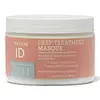What's inside
What's inside
 Key Ingredients
Key Ingredients

 Benefits
Benefits

 Concerns
Concerns

 Ingredients Side-by-side
Ingredients Side-by-side

Water
Skin ConditioningGlycerin
HumectantCetyl Alcohol
EmollientCarthamus Tinctorius Seed Oil
MaskingBehentrimonium Chloride
PreservativePrunus Amygdalus Dulcis Oil
Skin ConditioningHydrolyzed Vegetable Protein Pg-Propyl Silanetriol
Skin ConditioningParfum
MaskingPPG-3 Benzyl Ether Myristate
EmollientPhenoxyethanol
PreservativeCetrimonium Chloride
AntimicrobialHoney
HumectantEthylhexylglycerin
Skin ConditioningBenzoic Acid
MaskingArgania Spinosa Kernel Oil
EmollientGlycereth-2 Cocoate
EmulsifyingTocopheryl Acetate
AntioxidantWater, Glycerin, Cetyl Alcohol, Carthamus Tinctorius Seed Oil, Behentrimonium Chloride, Prunus Amygdalus Dulcis Oil, Hydrolyzed Vegetable Protein Pg-Propyl Silanetriol, Parfum, PPG-3 Benzyl Ether Myristate, Phenoxyethanol, Cetrimonium Chloride, Honey, Ethylhexylglycerin, Benzoic Acid, Argania Spinosa Kernel Oil, Glycereth-2 Cocoate, Tocopheryl Acetate
Water
Skin ConditioningCetyl Alcohol
EmollientCetearyl Alcohol
EmollientCetrimonium Chloride
AntimicrobialBehentrimonium Chloride
PreservativePropylene Glycol
HumectantSimmondsia Chinensis Seed Oil
EmollientArgania Spinosa Kernel Oil
EmollientHydrolyzed Vegetable Protein Pg-Propyl Silanetriol
Skin ConditioningTocopheryl Acetate
AntioxidantPanthenol
Skin ConditioningEthylhexylglycerin
Skin ConditioningDimethicone
EmollientParfum
MaskingPhenoxyethanol
PreservativePotassium Sorbate
PreservativeDisodium EDTA
Citric Acid
BufferingAscorbic Acid
AntioxidantWater, Cetyl Alcohol, Cetearyl Alcohol, Cetrimonium Chloride, Behentrimonium Chloride, Propylene Glycol, Simmondsia Chinensis Seed Oil, Argania Spinosa Kernel Oil, Hydrolyzed Vegetable Protein Pg-Propyl Silanetriol, Tocopheryl Acetate, Panthenol, Ethylhexylglycerin, Dimethicone, Parfum, Phenoxyethanol, Potassium Sorbate, Disodium EDTA, Citric Acid, Ascorbic Acid
 Reviews
Reviews

Ingredients Explained
These ingredients are found in both products.
Ingredients higher up in an ingredient list are typically present in a larger amount.
You may know this ingredient as argan oil. Argan Oil has antioxidant, hydrating, and soothing properties.
Studies have shown argan oil can help fight again radical damage from the sun. This makes it effective at preventing hyperpigmentation.
Large amounts of vitamin E found in argan oil helps the skin retain water. Argan oil also contains fatty acids such as linoleic acid, oleic acid, and palmitic acid. It is also a good source of lipids.
Another benefit of argan oil is skin-soothing. It can help reduce inflammation-related skin symptoms.
Argan Oil is effective at regulating sebum production in pores. This can make it effective at treating hormonal acne.
Traditionally, argan oil was used for its antibacterial and antifungal properties. However, argan oil contains fatty acids that may make it not fungal-acne safe.
Argan Trees are native to Morocco.
Learn more about Argania Spinosa Kernel OilThis ingredient is a preservative and often used for it's anti-static properties. You'll most likely see this ingredient in hair conditioners.
It does not cause irritation or sensitization in leave-on products at 1-5%.
This ingredient is a preservative, antimicrobial, and emulsifier. It is often used in cosmetics for its ability to cleanse, condition, and reduce static.
Cetrimonium chloride is a quaternary ammonium salt, meaning it has a water-soluble structure.
Cetyl Alcohol is a fatty alcohol. Fatty Alcohols are most often used as an emollient or to thicken a product.
Its main roles are:
Though it has "alcohol" in the name, it is not related to denatured alcohol or ethyl alcohol.
The FDA allows products labeled "alcohol-free" to have fatty alcohols.
Learn more about Cetyl AlcoholEthylhexylglycerin (we can't pronounce this either) is commonly used as a preservative and skin softener. It is derived from glyceryl.
You might see Ethylhexylglycerin often paired with other preservatives such as phenoxyethanol. Ethylhexylglycerin has been found to increase the effectiveness of these other preservatives.
We don't have a description for Hydrolyzed Vegetable Protein Pg-Propyl Silanetriol yet.
Parfum is a catch-all term for an ingredient or more that is used to give a scent to products.
Also called "fragrance", this ingredient can be a blend of hundreds of chemicals or plant oils. This means every product with "fragrance" or "parfum" in the ingredients list is a different mixture.
For instance, Habanolide is a proprietary trade name for a specific aroma chemical. When used as a fragrance ingredient in cosmetics, most aroma chemicals fall under the broad labeling category of “FRAGRANCE” or “PARFUM” according to EU and US regulations.
The term 'parfum' or 'fragrance' is not regulated in many countries. In many cases, it is up to the brand to define this term.
For instance, many brands choose to label themselves as "fragrance-free" because they are not using synthetic fragrances. However, their products may still contain ingredients such as essential oils that are considered a fragrance by INCI standards.
One example is Calendula flower extract. Calendula is an essential oil that still imparts a scent or 'fragrance'.
Depending on the blend, the ingredients in the mixture can cause allergies and sensitivities on the skin. Some ingredients that are known EU allergens include linalool and citronellol.
Parfum can also be used to mask or cover an unpleasant scent.
The bottom line is: not all fragrances/parfum/ingredients are created equally. If you are worried about fragrances, we recommend taking a closer look at an ingredient. And of course, we always recommend speaking with a professional.
Learn more about ParfumPhenoxyethanol is a preservative that has germicide, antimicrobial, and aromatic properties. Studies show that phenoxyethanol can prevent microbial growth. By itself, it has a scent that is similar to that of a rose.
It's often used in formulations along with Caprylyl Glycol to preserve the shelf life of products.
Tocopheryl Acetate is AKA Vitamin E. It is an antioxidant and protects your skin from free radicals. Free radicals damage the skin by breaking down collagen.
One study found using Tocopheryl Acetate with Vitamin C decreased the number of sunburned cells.
Tocopheryl Acetate is commonly found in both skincare and dietary supplements.
Learn more about Tocopheryl AcetateWater. It's the most common cosmetic ingredient of all. You'll usually see it at the top of ingredient lists, meaning that it makes up the largest part of the product.
So why is it so popular? Water most often acts as a solvent - this means that it helps dissolve other ingredients into the formulation.
You'll also recognize water as that liquid we all need to stay alive. If you see this, drink a glass of water. Stay hydrated!
Learn more about Water